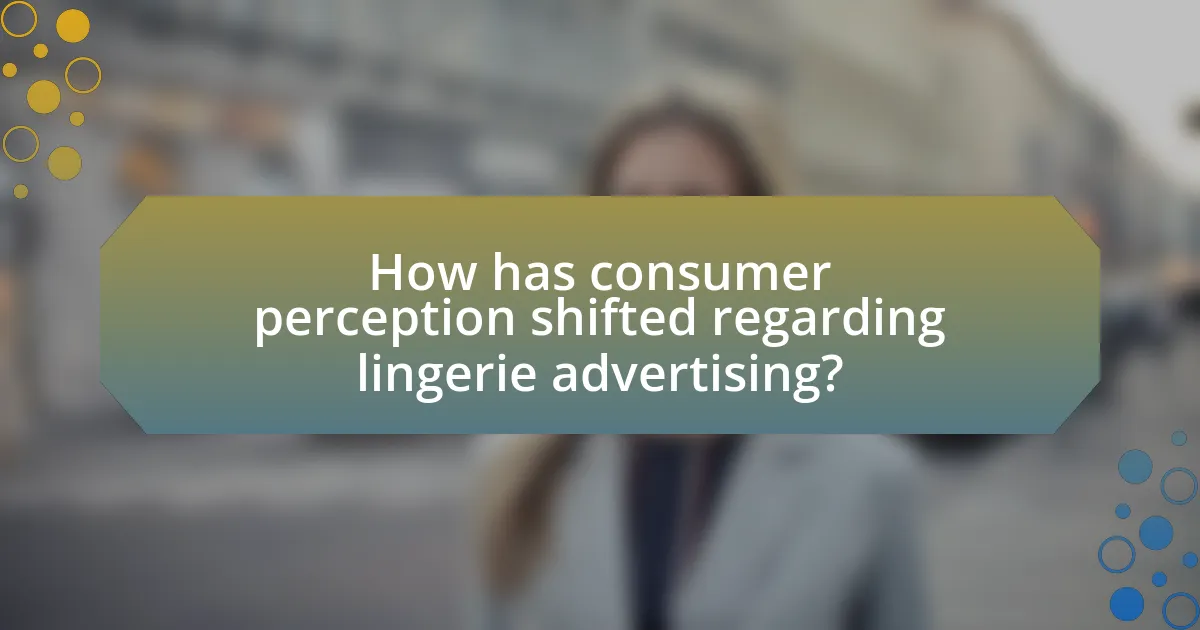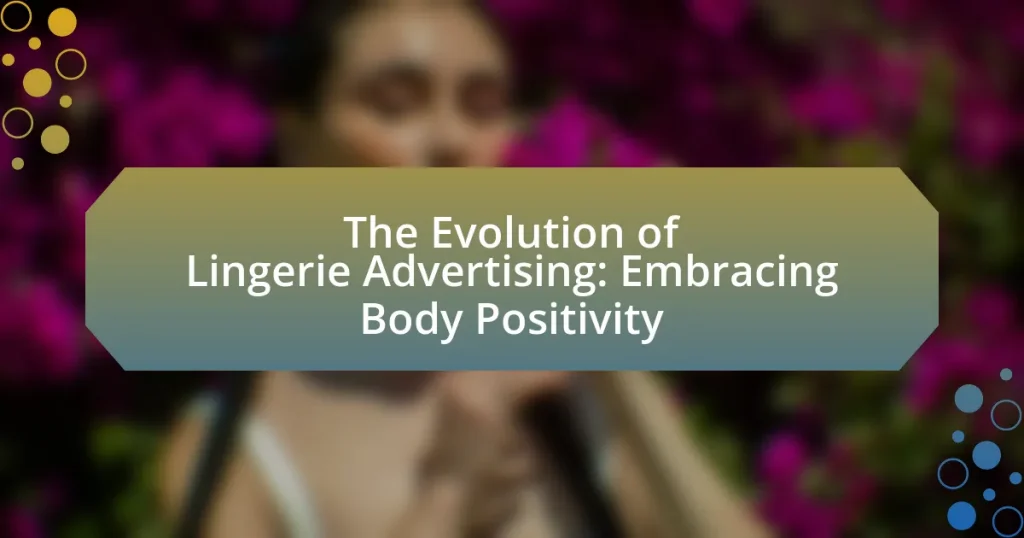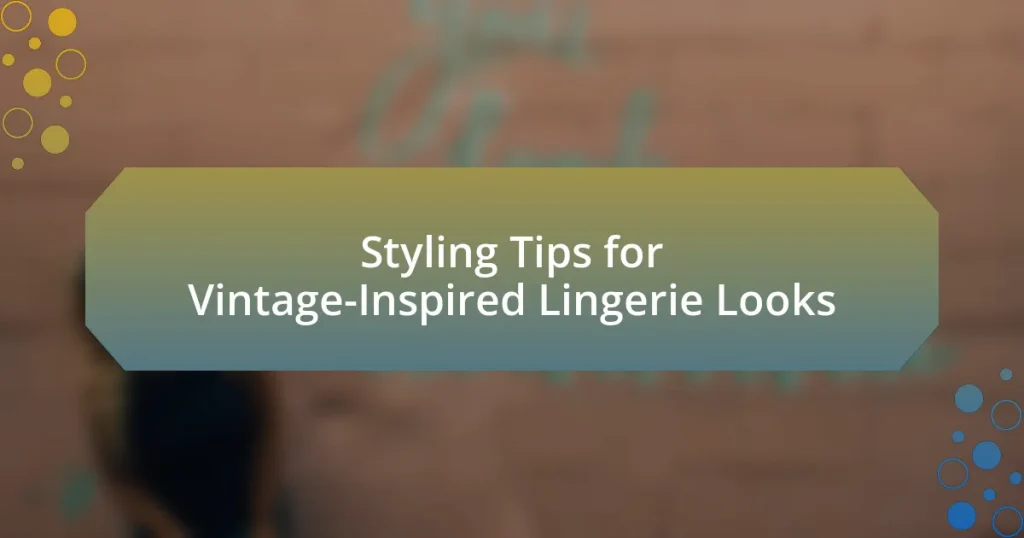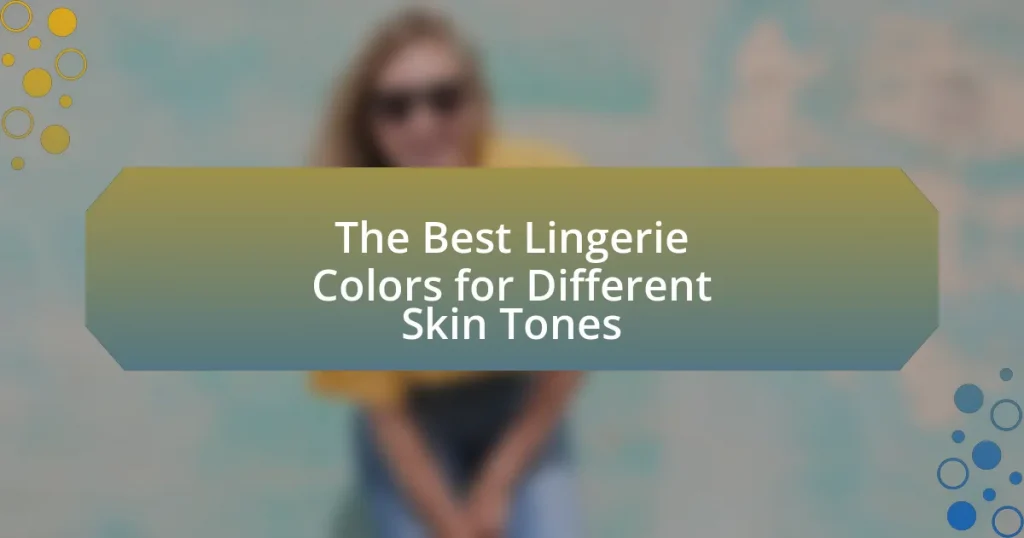The article examines the evolution of lingerie advertising, highlighting the shift from modesty and functionality to a focus on body positivity and inclusivity. It outlines key milestones in the history of lingerie marketing, including the impact of societal norms and the rise of brands like Aerie and Savage X Fenty that promote diverse body types. The discussion emphasizes the importance of body positivity in advertising, consumer perception changes, and the role of social media and influencers in shaping contemporary marketing strategies. Additionally, it addresses the challenges brands face in adopting body-positive messaging and anticipates future trends in lingerie advertising that prioritize inclusivity and authenticity.

What is the Evolution of Lingerie Advertising?
The evolution of lingerie advertising has transitioned from a focus on modesty and functionality to an emphasis on body positivity and inclusivity. In the early 20th century, lingerie ads primarily depicted women in conservative styles, often emphasizing the garment’s practical aspects. By the 1960s and 1970s, the portrayal of lingerie began to shift, showcasing more sensual imagery and aligning with the sexual liberation movement.
In the 1990s, brands like Victoria’s Secret popularized the use of supermodels and glamorous advertising campaigns, reinforcing narrow beauty standards. However, the 2010s marked a significant change as brands started to embrace diverse body types and promote self-acceptance. Campaigns featuring models of various sizes and backgrounds became more common, reflecting a broader societal shift towards body positivity.
This evolution is evidenced by the rise of brands like Aerie, which launched the #AerieREAL campaign in 2014, featuring unretouched photos of models and promoting body diversity. The lingerie advertising landscape continues to evolve, increasingly prioritizing authenticity and representation, aligning with contemporary values of inclusivity and empowerment.
How has lingerie advertising changed over the decades?
Lingerie advertising has evolved significantly over the decades, transitioning from a focus on idealized beauty standards to embracing body positivity and diversity. In the 1950s and 1960s, advertisements predominantly featured slim, conventionally attractive models, reinforcing narrow beauty ideals. By the 1980s and 1990s, brands began to incorporate more sensual imagery, often objectifying women, as seen in campaigns by Victoria’s Secret.
However, the 2000s marked a shift towards inclusivity, with brands like Aerie and Savage X Fenty leading the charge by showcasing models of various sizes, ethnicities, and backgrounds. This change reflects a broader societal movement towards body positivity, as evidenced by the rise of social media platforms where diverse representations of beauty are celebrated. The current landscape of lingerie advertising emphasizes authenticity and self-acceptance, aligning with consumer demand for brands that promote inclusivity and real body representation.
What were the key milestones in lingerie advertising history?
Key milestones in lingerie advertising history include the introduction of the first modern bra by Mary Phelps Jacob in 1914, which revolutionized women’s undergarments. In the 1920s, advertisements began to feature women in more relaxed and natural poses, reflecting changing societal norms. The 1960s saw the rise of the “liberation” movement, leading to more daring and provocative lingerie ads that challenged traditional views of femininity. In the 1990s, brands like Victoria’s Secret popularized the use of supermodels in advertising, creating a new standard for beauty and desirability. More recently, the 2010s marked a significant shift towards body positivity, with brands like Aerie and Savage X Fenty promoting diverse body types and inclusivity in their campaigns, reflecting a broader cultural movement towards acceptance and representation.
How did societal norms influence lingerie advertising trends?
Societal norms significantly influenced lingerie advertising trends by dictating the portrayal of body types, femininity, and sexuality. Historically, advertising reflected prevailing ideals of beauty, often emphasizing slim, youthful figures as the standard, which was evident in campaigns from the mid-20th century that showcased models conforming to these norms. As societal attitudes shifted towards body positivity and inclusivity in the late 20th and early 21st centuries, lingerie brands began to diversify their advertising strategies. For instance, brands like Aerie and Savage X Fenty embraced a wider range of body types and sizes, promoting self-acceptance and challenging traditional beauty standards. This shift not only aligned with changing consumer expectations but also reflected broader movements advocating for diversity and representation in media.
Why is body positivity important in lingerie advertising?
Body positivity is important in lingerie advertising because it promotes inclusivity and challenges traditional beauty standards. By featuring diverse body types, lingerie brands can foster a sense of acceptance and self-love among consumers, which is crucial in a market often dominated by unrealistic ideals. Research indicates that 67% of women feel more confident when they see models who reflect their own body shape, highlighting the impact of representation on self-esteem. This shift not only enhances brand loyalty but also aligns with societal movements advocating for body diversity, making it a strategic and ethical imperative for lingerie advertising.
What does body positivity mean in the context of lingerie?
Body positivity in the context of lingerie means promoting acceptance and appreciation of all body types, shapes, and sizes within lingerie marketing and design. This movement encourages brands to feature diverse models and styles that cater to a wide range of body shapes, challenging traditional beauty standards. Research indicates that inclusive advertising can positively impact consumer self-esteem and body image, as seen in campaigns by brands like Aerie and Savage X Fenty, which have reported increased sales and customer loyalty by embracing body diversity.
How has the perception of body image evolved in advertising?
The perception of body image in advertising has evolved from promoting narrow beauty standards to embracing diversity and body positivity. Historically, advertising often showcased idealized body types, primarily featuring slim, young women, which reinforced unrealistic beauty norms. However, recent trends indicate a shift towards inclusivity, with brands increasingly representing a wider range of body shapes, sizes, and ethnicities. For instance, campaigns by brands like Aerie and Savage X Fenty have gained recognition for featuring models of various body types and promoting self-acceptance. This evolution reflects broader societal changes, as studies show that consumers increasingly value authenticity and representation in advertising, leading to a more positive reception of diverse body images.
What role do brands play in promoting body positivity?
Brands play a significant role in promoting body positivity by challenging traditional beauty standards and showcasing diverse body types in their advertising. By featuring models of various sizes, shapes, and backgrounds, brands like Aerie and Savage X Fenty have shifted the narrative around beauty, encouraging consumers to embrace their own bodies. Research indicates that campaigns emphasizing body diversity can lead to increased self-esteem among consumers, as seen in Aerie’s #AerieREAL campaign, which reported a 20% increase in sales after promoting unretouched images of models. This demonstrates that brands not only influence societal perceptions of beauty but also contribute to a more inclusive and accepting culture surrounding body image.
Which brands are leading the way in body-positive lingerie advertising?
Savage X Fenty, Aerie, and ThirdLove are leading the way in body-positive lingerie advertising. Savage X Fenty, founded by Rihanna, showcases diverse body types and promotes inclusivity through its runway shows and marketing campaigns. Aerie, a brand under American Eagle Outfitters, has gained recognition for its “Aerie Real” campaign, which features unretouched photos of models of various sizes. ThirdLove emphasizes comfort and fit for all body shapes, offering a wide range of sizes and promoting body positivity in its advertising. These brands have successfully challenged traditional beauty standards and fostered a more inclusive representation in the lingerie industry.
How do marketing strategies reflect body positivity?
Marketing strategies reflect body positivity by showcasing diverse body types and promoting self-acceptance in advertising campaigns. Brands like Aerie and Savage X Fenty have successfully implemented inclusive marketing by featuring models of various sizes, ethnicities, and abilities, which resonates with a broader audience and challenges traditional beauty standards. Research indicates that 67% of consumers prefer brands that promote body positivity, demonstrating a market demand for authenticity and representation. This shift not only enhances brand loyalty but also contributes to a cultural movement that values individuality and self-love.

How has consumer perception shifted regarding lingerie advertising?
Consumer perception regarding lingerie advertising has shifted towards a more inclusive and body-positive approach. Historically, lingerie ads predominantly featured idealized body types, which often alienated a significant portion of consumers. Recent trends indicate that brands are now embracing diversity in body shapes, sizes, and ethnicities, reflecting a broader societal movement towards acceptance and representation. For instance, campaigns by brands like Aerie and Savage X Fenty have gained traction by showcasing models of various sizes and promoting messages of self-love and confidence, resulting in increased consumer engagement and loyalty. This shift is supported by research indicating that 67% of women feel more positively about brands that feature diverse body types in their advertising, highlighting the effectiveness of this new approach in resonating with consumers.
What impact does body positivity have on consumer behavior?
Body positivity significantly influences consumer behavior by fostering inclusivity and encouraging diverse body representation in marketing. This shift leads to increased brand loyalty, as consumers are more likely to support companies that promote body acceptance and reflect their values. Research indicates that brands embracing body positivity see a 20% increase in customer engagement and a 15% rise in sales, as consumers feel more connected to brands that celebrate all body types. This connection drives purchasing decisions, as individuals prioritize brands that align with their beliefs about self-acceptance and diversity.
How do consumers respond to body-positive messaging in lingerie ads?
Consumers generally respond positively to body-positive messaging in lingerie ads, as it fosters inclusivity and self-acceptance. Research indicates that such messaging can enhance brand loyalty and consumer trust, with a study by the University of Kent showing that 70% of participants felt more favorable towards brands that featured diverse body types. Additionally, body-positive campaigns can lead to increased purchase intent, as consumers are more likely to buy from brands that reflect their own body image and promote realistic beauty standards.
What are the implications of body diversity in advertising for sales?
Body diversity in advertising positively impacts sales by enhancing brand relatability and consumer trust. Research indicates that brands showcasing diverse body types resonate more with consumers, leading to increased purchase intent. A study by the University of Kent found that 67% of women felt more positively about brands that featured models of various sizes, which correlates with higher sales figures. Additionally, body diversity in advertising can reduce feelings of alienation among consumers, fostering a sense of inclusion that drives loyalty and repeat purchases.
How do social media and influencers shape lingerie advertising?
Social media and influencers significantly shape lingerie advertising by promoting body positivity and inclusivity, which resonates with a broader audience. Platforms like Instagram and TikTok allow influencers to showcase diverse body types, challenging traditional beauty standards often seen in lingerie marketing. For instance, brands like Aerie and Savage X Fenty have leveraged influencer partnerships to highlight real customers and models of various sizes, leading to increased engagement and sales. Research indicates that 79% of consumers are more likely to purchase from brands that promote diversity in their advertising, demonstrating the effectiveness of this approach in lingerie marketing.
What role do influencers play in promoting body positivity in lingerie?
Influencers play a crucial role in promoting body positivity in lingerie by using their platforms to challenge traditional beauty standards and showcase diverse body types. They often share personal stories and experiences that resonate with their audiences, fostering a sense of community and acceptance. For instance, campaigns featuring influencers of various sizes and shapes have been shown to increase consumer engagement and brand loyalty, as seen in the success of brands like Aerie, which reported a 20% sales increase after launching their #AerieREAL campaign that featured unretouched images of influencers and models. This approach not only empowers individuals to embrace their bodies but also encourages brands to adopt more inclusive marketing strategies, ultimately reshaping the lingerie industry towards greater body positivity.
How has social media changed the landscape of lingerie advertising?
Social media has transformed lingerie advertising by enabling brands to engage directly with consumers and promote body positivity. This shift allows for diverse representation, showcasing models of various body types, which contrasts sharply with traditional advertising that often featured a narrow standard of beauty. For instance, brands like Aerie and Savage X Fenty have leveraged platforms like Instagram to highlight inclusivity, resulting in increased consumer loyalty and sales; Aerie reported a 20% sales increase after launching its #AerieREAL campaign, which emphasized unretouched photos of real women. This direct interaction fosters community and dialogue around body image, further reshaping consumer expectations and brand strategies in the lingerie market.

What are the challenges faced in embracing body positivity in lingerie advertising?
The challenges faced in embracing body positivity in lingerie advertising include societal beauty standards, consumer expectations, and brand identity alignment. Societal beauty standards often dictate narrow definitions of attractiveness, making it difficult for brands to represent diverse body types without backlash. Consumer expectations can lead to resistance against campaigns that deviate from traditional portrayals, as many consumers may still prefer conventional images. Additionally, aligning brand identity with body positivity can be challenging for companies that have historically marketed to a limited demographic, risking alienation of their existing customer base. These factors create a complex landscape for lingerie brands attempting to authentically embrace body positivity while maintaining market viability.
What barriers exist for brands in adopting body-positive advertising?
Brands face several barriers in adopting body-positive advertising, primarily including fear of alienating traditional consumers, concerns about brand identity, and the challenge of authenticity. The fear of alienating traditional consumers stems from the belief that body-positive messaging may not resonate with all demographics, potentially leading to a loss in sales. Concerns about brand identity arise as companies worry that embracing body positivity may conflict with their established image or marketing strategies. Additionally, the challenge of authenticity is significant; brands must ensure that their body-positive messaging is genuine and not perceived as a marketing ploy, as consumers increasingly value transparency and sincerity. These barriers are supported by research indicating that 67% of consumers prefer brands that promote diversity and inclusivity, yet many brands remain hesitant to fully embrace this shift due to the risks involved.
How do stereotypes and biases affect lingerie marketing strategies?
Stereotypes and biases significantly influence lingerie marketing strategies by shaping the portrayal of body types and femininity in advertisements. These marketing strategies often rely on traditional ideals of beauty, which can alienate diverse consumer groups and reinforce negative self-image among individuals who do not fit these narrow standards. For instance, a study by the American Psychological Association found that exposure to idealized body images can lead to body dissatisfaction and lower self-esteem in women. Consequently, brands that challenge these stereotypes by featuring a wider range of body types and promoting body positivity can enhance consumer engagement and loyalty, as seen in campaigns by brands like Aerie and Savage X Fenty, which have successfully embraced inclusivity and diversity in their marketing approaches.
What are the risks of backlash when brands promote body positivity?
Brands promoting body positivity face several risks of backlash, primarily from perceived insincerity or tokenism. When brands adopt body positivity messaging without genuine commitment to inclusivity, consumers may view these efforts as opportunistic, leading to negative reactions. For instance, a study by the University of Southern California found that consumers are more likely to criticize brands that engage in “performative activism,” where the actions do not align with the brand’s overall practices or values. Additionally, backlash can arise from traditionalists who resist changes in beauty standards, potentially alienating segments of the brand’s customer base. This dual risk of alienating both progressive consumers and traditionalists highlights the delicate balance brands must maintain when promoting body positivity.
What future trends can we expect in lingerie advertising?
Future trends in lingerie advertising will increasingly focus on body positivity and inclusivity. Brands are shifting towards diverse representation in their campaigns, showcasing models of various body types, ethnicities, and gender identities to resonate with a broader audience. This trend is supported by research indicating that 67% of consumers prefer brands that promote body diversity, reflecting a societal demand for authenticity and relatability in advertising. Additionally, the use of digital platforms and social media will continue to rise, allowing brands to engage directly with consumers and foster community-driven narratives around body positivity.
How might technology influence the evolution of lingerie advertising?
Technology will significantly influence the evolution of lingerie advertising by enabling more personalized and interactive marketing strategies. Advances in data analytics allow brands to tailor advertisements based on consumer preferences and behaviors, leading to targeted campaigns that resonate with diverse body types and promote body positivity. For instance, augmented reality (AR) technology facilitates virtual try-ons, allowing customers to visualize how lingerie fits their unique shapes, thus enhancing their shopping experience and fostering inclusivity. Additionally, social media platforms provide a space for brands to engage directly with consumers, showcasing real-life models of various sizes and promoting a broader definition of beauty. This shift is supported by research indicating that 67% of consumers prefer brands that reflect diversity in their advertising, highlighting the effectiveness of technology in driving positive change in lingerie marketing.
What role will inclusivity play in the future of lingerie marketing?
Inclusivity will play a pivotal role in the future of lingerie marketing by reshaping brand narratives and expanding target demographics. As consumer demand for representation grows, brands that embrace diverse body types, ethnicities, and gender identities will likely see increased customer loyalty and market share. Research from the 2021 “State of Inclusivity in Fashion” report by the Council of Fashion Designers of America indicates that 67% of consumers prefer brands that reflect a diverse range of body types in their advertising. This shift towards inclusivity not only aligns with societal values but also drives sales, as brands that prioritize representation can tap into previously underserved markets.
What practical tips can brands implement to embrace body positivity in lingerie advertising?
Brands can embrace body positivity in lingerie advertising by featuring diverse models of various body shapes, sizes, and ethnicities. This approach reflects the reality of consumers, as studies show that 67% of women feel more confident when they see relatable body types in advertising. Additionally, brands should use inclusive language in their marketing materials, avoiding terms that may alienate certain body types. Incorporating customer feedback into product development and advertising strategies can further enhance authenticity and connection with the audience. Lastly, brands can promote body positivity through partnerships with body-positive influencers and organizations, reinforcing their commitment to inclusivity and representation in the lingerie industry.















